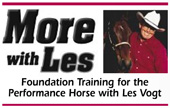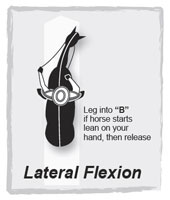 Next in a series
Next in a series
After reviewing our foundation last issue, we look at an important exercise for flexion.
Basic Steering
Even if you have a trained horse that you’ve ridden for years, it’s important that you don’t skip this section. If you’re tempted, ask yourself these questions:
(1) When I start to pick up one rein, does my horse start to give his nose BEFORE I’ve taken all the slack out of that rein?
(2) When my horse turns his head in response to rein pressure, does he bend his whole neck and keep his head more or less perpendicular to the ground and level with his withers, or does he twist his neck and just stick his nose toward the direction I’m pulling him?
If he doesn’t respond to your lateral, or side-to-side, rein pressure from a light cue and with proper form, you’ll never get the soft vertical flexion you need for the high-performance events. So stick with us – this “retraining” alone might have a profound effect on your horse’s performance.
 The Procedure
The Procedure
Here’s the procedure: As you are walking along in a straight line, pick up one rein and make soft contact with the bit. If your horse doesn’t immediately start to yield, initiate the bend by pressing with your inside leg (the same side as the rein you are picking up) while you softly work the corner of the horse’s mouth by just squeezing your fingers like you would squeeze a sponge.
Release and Reward
At first, you’ll want to release the rein pressure as soon as the horse gives to your hand – so he understands that’s all that you wanted, and that it was really easy. If he starts to give when he feels you pick up the rein, you may even stop and just praise him. As always they will learn the quickest when you are consistent with your cues, and you make it very clear when they’ve done right by releasing the pressure
and rewarding their effort.
Twisted Head = Twisted Spine
If your horse responds to your rein pressure by twisting his head rather than bending his neck, you’re going to need to use your indirect rein to keep his nose in and down as he turns. To help you understand the difference, think of it this way: If the form is correct the horse’s ears should stay close to level as he bends his neck around. If he’s twisting his head you will see the outside ear dropping as his head moves sideways. This may seem minor now but this form will become really critical when you start to do turnarounds.
If the horse’s neck is twisted it will not only be harder for him to step around the turn with the outside front leg, but it will send his weight to the outside hind leg rather than to the inside pivot foot. So as you can see, achieving the correct form now will pay off in spades as your training progresses.
Start With the Inside Rein
Another thing you want to be conscious of is that you try to keep your horse’s head about level with his withers, or even lower, as he turns it from side to side. You don’t want him to lift; you just want him to turn. If he does start to lift or twist his head, try bumping him just enough with the outside rein to get his nose down as he turns. Since our goal is for the horse to initiate the correct form on his own, always start your flexions with just the inside rein, and then add the outside one only if he gets out of form.
When you are starting a colt, you show him how to respond to a rein by pulling it out to the side and directing him. As soon as he starts to get it you’ll want to start keeping your hands closer to your body and to literally pick up the rein to initiate the bend. This will encourage him to keep his chin closer to his body like we want, rather than sticking his nose out to the side. Lifting up the hand also encourages your horse to keep his shoulders up rather than leaning into the turn, another concept that will become critical further down the line.
Once you feel confident with lateral flexion at the walk go ahead and try it at the jog and lope so that every time you turn your horse you’re asking for this form: neck curled toward the direction of the turn, head fairly level and shoulders straight up and down.
Editor’s Note: More with Les is a regular California Horsetrader column. Les Vogt has won more than 15 World Championships, including two wins at the NRCHA Snaffle Bit Futurity. Although Les still rides and occasionally shows, his focus is giving clinics around the world and developing products for the performance horseman. To learn more about Les and to see his clinic schedule, visit the Web site: www.lesvogt.com
Leave a Comment
All fields must be filled in to leave a message.